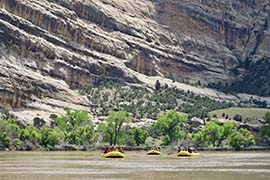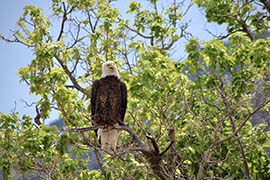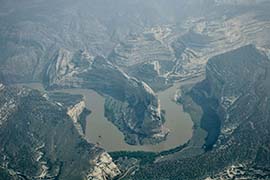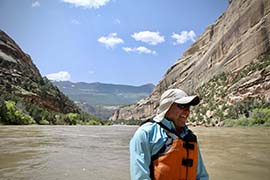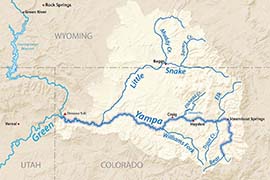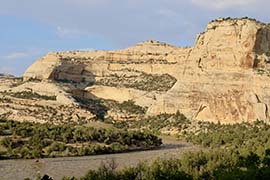EDS: This is a partner story from KUNC. If you choose to use it, please fill out this form to help their tracking.
- Slug: BC-CNS-Yampa Running,2100 words.
- 7 photos, audio story available (thumbnails, captions below).
By Alex Hager
KUNC
Colorado’s Yampa River is the highest it’s been in more than a decade, and that means big rapids.
“It’s like a roller coaster, only there’s no rail,” said Ken Brenner, grinning from his perch on the side of a yellow rubber raft. “You’re all at the mercy of the water and your helmsman.”
The Yampa starts near the ski town of Steamboat Springs, Colorado, then flows west across wide sagebrush plains and the towering canyon walls of Dinosaur National Monument. Just before the Utah border, it merges with the Green River before joining the Colorado and flowing into Lake Powell.
Brenner, who grew up on a ranch near Steamboat Springs, now serves on the Interbasin Compact Committee, a Colorado water policy group. He was one of 30 people on a late May educational rafting trip, watching the Colorado River system refill in real time. After an epically snowy year in the Rocky Mountains, the Yampa is carrying water and sediment downstream in abundance, providing a much-needed boost for a parched river system.
Alyssa Schaffer tightened her grip on the handles of heavy fiberglass oars and pushed the boat into a turbulent section of whitewater. The raft’s nose dipped beneath a cresting wave, sending a slosh over the boat’s edge and onto Brenner.
“Every time we come around the corner, we don’t know what to expect,” Schaffer said. “Are we going to see big holes that we have to avoid? Is camp going to be harder to catch? Is there going to be an eddy there? All kinds of unexpected, amazing stuff happening.”
The experienced raft guides leading this trip had run the Yampa dozens of times, but still marveled at surprises every few miles. One guide pointed out a little, unthreatening riffle near the river’s swollen banks and said it was the tip of a house-sized boulder. Campsites with wide, sandy beaches were almost completely drowned, forcing the raft guides to park the boats near half-submerged trees on the grassy shore.
Snow piled up in the mountains all winter. In mid-April when snowpack was at its deepest, snow totals in the Yampa basin were at 149% of normal. All that snow has been melting in the spring sun, sending a huge rush of water through the river. At its peak, the river climbed just above 20,000 cubic feet per second, a mark it hadn’t reached since 2011. In an average year, the river peaks at 8,200 cubic feet per second.
Rivers like the Yampa are the beating heart of the West’s water supply. The Colorado River supplies tens of millions of people and a multibillion dollar agricultural industry from Wyoming to Mexico, but about two thirds of that water starts as snow in the state of Colorado.
Climate change has driven temperatures up, causing snow to fall less, melt faster and disappear before it has a chance to reach streams, rivers and reservoirs. That means a year like this one defies recent trends and provides a surge of water that’s getting increasingly rare with each year the planet warms.
The last wild river
Up close, the raging, roiling waters of once-in-a-decade high flows on the Yampa make for an exhilarating raft trip. On paper, they represent a much needed breath of fresh air for stressed water managers throughout the Southwest. The water will flow through the Yampa and Colorado rivers before it hits Lake Powell, helping pull the imperiled reservoir back from the brink of catastrophe.
“We are quite literally being saved by the Yampa basin right now,” said Matt Rice, Southwest regional director for the conservation group American Rivers. “Every molecule of water is important, and the Yampa is delivering on such a monster scale right now.”
American Rivers receives funding from the Walton Family Foundation, which also funds a portion of KUNC’s Colorado River coverage. Sitting just feet from the river’s banks after a long day of navigating rapids, Rice elaborated over the sound of rushing water.
“The tap is swung fully open right now,” he said. “We’re seeing that happen here.”
The Yampa holds a special place in the heart of conservationists, who regard it as one of the West’s last “wild” rivers. Most of the region’s waterways are deeply shaped and sculpted by humans. In the Colorado River basin, rivers have been dammed, diverted and turned into pieces of anthropogenic infrastructure – serving as conduits to carry a finicky water supply to the homes, businesses, and farms that depend on it.
The Yampa is different.
Its water is not carried across mountains and against gravity to reach cities on Colorado’s populous Front Range. Its high flows are not the result of releases from a big dam. It’s not entirely untouched by people, but it generally functions like Western rivers did before humans wrangled them.
“I get so much joy seeing a river that changes every year,” said Lindsey Marlow, executive director of Friends of the Yampa. “Seeing it in this way makes my heart swell and I get so excited. I feel connected. The rapids are huge. It’s knowing that this might be it. This may be the last time you see it this way.”
At one point on the rafting trip, the Yampa intersects with the Green River, which provides a stark contrast. Even after a winter of deep snow in the Wind River mountain range of Wyoming, it’s reduced to a gentler, restrained flow by the time it reaches the Yampa. Between its source and the confluence, it’s held up by Flaming Gorge dam, where snowmelt is carefully managed and released in increments.
The Yampa was once itself almost dammed, when a 1950s proposal from the federal government suggested building a dam near the river’s Echo Park area and turning the canyon into a reservoir. Resistance to the dam, which was eventually abandoned in favor of building Glen Canyon dam in Arizona, helped to spark the modern environmental movement.
“When we talk about the greater Colorado system, we really focus on it as a commodity,” she said. “We’re buying and trading, and we seem to forget the people and the habitats and the animals and the fish along the way. It’s almost like the domino effect. You knock one over, they all fall, and you don’t know – by changing things and controlling things – how much that affects the greater whole.”
Reducing pressure on fish and fields
High water on the Yampa is a mood booster for just about everyone that has a stake in the river. The rafting trip brings together policymakers, biologists, conservationists and recreators, to name a few – and each of them has their own reasons to rejoice the surging runoff.
Tildon Jones, associate director for the Upper Colorado River Endangered Fish Recovery Program, listed the benefits to native fish.
The endangered razorback sucker has better odds of reproducing successfully during high flows, since larval fish are swept into nearby wetlands where they can grow faster in warm water that’s stocked with food. For the Colorado pikeminnow, which is also endangered, fast-moving water picks up sediment and creates new sandbars that make excellent habitat for young fish.
“In past years, 2011 in particular, which is the last time we saw flows of this magnitude, we saw a really positive native fish response,” Jones said.
Before the Yampa River reaches the deep, shady canyons that cradle big rapids and faraway fish habitats, it runs alongside ranch lands. Since the early 1900s, long before Steamboat Springs became a destination ski resort, the valley around the river has been home to a robust agricultural industry.
This year, snow lingered long into the spring. That made it challenging for cows to birth and raise their calves, but melting snow has been a helpful boost for grazing fields.
“It just reduces that pressure,” said Todd Hagenbuch, a fourth-generation rancher who serves as an agriculture specialist for Colorado State University Extension in Routt County. “Hopefully it leads to increased yields, which of course then leads to increased bottom dollar. And that’s something that our ranchers need for sure.”
At the same time, Hagenbuch knows dry conditions could come back soon.
“One year does not a trend make,” he said, “So we’re cautiously optimistic for this year. But with an eye towards the future, how do we take this year to rebuild, reprieve and plan for the next dry years?”
‘One good year does not save us’
Just like ranchers, water managers are feeling a weight lifted off of their shoulders by this snowy winter, as well as mounting pressure to plan for the years ahead. A recent proposal to cut back on water use in California, Arizona and Nevada was made possible in part by the influx of water from the Yampa and other rivers like it.
“One good year does not save us,” said Matt Rice with American Rivers. “But what it does is it buys us time. We’re really grateful that this river has created the political space for us to make the hard decisions that we need to make.”
Climate scientists say the West would need five or six consecutive strong winters to pull the Colorado River out of trouble, but that is unlikely due to climate change. Instead, experts agree that states must agree on ways to reduce demand and come to terms with the reality of a shrinking river system.
This spring surge takes pressure off of Lake Powell, where dropping reservoir levels have threatened to cause a hydropower shutdown, and water managers were forced to prop it up with emergency releases from other reservoirs. The wet winter puts out that small fire, but barely chips away at the critical supply-demand imbalance that is straining the Colorado River.
To solve that, water managers from the seven states that use the river will need to agree on painful cutbacks. The current rules for sharing the river are set to expire in 2026, and must be replaced before then. In the lead-up, states are caught in a standoff, largely unwilling to volunteer reductions to their water use, which would take water away from farms and some urban areas.
Much of the debate has centered around water use on farms and ranches, since the agriculture sector uses about 80% of the Colorado River’s water.
Another member of the Yampa rafting trip is advocating for better representation of a group that has been largely left out of conversations about the river’s future – Indigenous tribes.
The artist Ed Kabotie, who is Tewa and Hopi, serenaded the rafting group with campfire songs, including some about water. He said water is what connects people together.
“In our cultural belief about how we came into this world, we come from water,” Kabotie said, “We’re farming people, so we have songs about the clouds, we have songs about raindrops, we have songs about water hitting water, puddles of water, the splash that it makes, frogs croaking when they’re in the fields after the monsoons come.”
Even though native tribes have been using water longer than anyone else in the region, they say they have been excluded from discussions about how the Colorado River is shared – both in foundational talks over a century ago, and today’s negotiations about how to correct the 21st century’s supply-demand imbalance.
“When we have these discussions like we have on this river about water law and about water policy, honestly, it’s enraging,” Kabotie said. “It really is enraging because Indigenous people were pushed off the landscape. And now a larger culture that pushed us off is coming in to create playgrounds for themselves and to make decisions about what happens with that water while we are completely left off that, off the table.”
Sitting on a massive tree root, just feet away from the rushing Yampa, Kabotie said the sorrow and anger he feels about tribal exclusion weren’t what defined the river trip.
“The essence of the river trip has been interacting with the river and the springs and visiting ancestral sites,” he said. “I’ve been climbing rocks and jumping in rivers and taking runs. I’m overwhelmed, you know?”
The Yampa, itself still overwhelmed by frothing rapids and surging currents, will likely keep flowing strong through June, before tapering off into the summer. Lindsay Marlow, who runs the conservation group that helped organize the raft trip, said seeing it up close helps add valuable context to the broader river system.
“Wherever people are before they make decisions about anything,” she said, “I implore people to think about cause and effect and to put yourself in people’s shoes, but also go visit these places.”
– This story is part of ongoing coverage of the Colorado River, produced by KUNC and supported by the Walton Family Foundation.
For more stories from Cronkite News, visit cronkitenews.azpbs.org.
^__=
A group of rafts floats down a calm section of the Yampa River on May 23, 2023. High flows have been a boon for recreators, fish and ranchers alike. The high water has also lifted some pressure of water managers trying to reduce demand on the Colorado River. (Photo by Alex Hager/KUNC)
A bald eagle perches on a branch near the Yampa River on May 24, 2023. This wet spring has been a boon for wildlife, as strong river flows rebuild fish habitat and keep trees and bushes lush and full of birds. (Photo by Alex Hager/KUNC)
The Yampa River bends around Steamboat Rock near its confluence with the Green River on May 19, 2023. The federal government once proposed flooding this area to create a reservoir in the 1950s, eventually opting to create Lake Powell instead. (Photo by Alex Hager/EcoFlight/KUNC)
Ken Brenner sits on the edge of a raft while floating down the Yampa River on May 21, 2023. “It’s like a roller coaster,” he says, “Only there’s no rail.” After an epic snow year in the mountains, the Yampa is full of raging rapids as water moves swiftly towards the Colorado River. (Photo by Alex Hager/KUNC)
A map of the Yampa River follows its flow from the mountains of Colorado to its confluence with the Green River, near the Utah border. (Map courtesy of Courtesy of American Rivers)
Water rushes through the Yampa River on May 21, 2023. With water the highest it’s been in more than a decade, rapids are reshaped and campsite beaches are completely drowned. (Photo by Alex Hager/KUNC)
Ed Kabotie holds up his sketch of the Yampa River on May 23, 2023. Kabotie, who is Tewa and Hopi, draws inspiration from water and rivers. (Photo by Alex Hager/KUNC)
